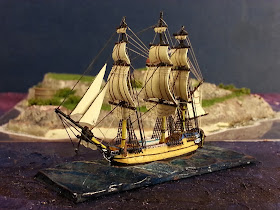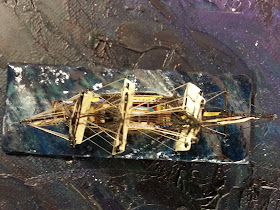Over a year ago there was a gentleman posting on the Sails of Glory Anchorage site a scratch build of the "Horrible Old Leopard" 50 gun ship. He only got so far and never finished. I was very intrigued and very disappointed as I really wanted to see how it turned out.
I have been thinking about it ever since and decided to try it myself. I bought the book "The 50-Gun Ship" by Rif Winfield that includes plans for several 50 gun ships including the Leopard.
So the first thing I did was take photos of the deck plans and side profile then I started a Microsoft Word file and added the photos. Re-sizing them to 1/1200 scale was not easy. I printed out several sheets too big or too small until I finally got it right. Having GHQ and Langton unbuilt 50 gun hulls for comparison helped. Once I got it right, I went ahead and added some plans I pulled off the internet for Ville de Paris and Bellona as well.
Next I cut out the decks and glued them to 1/16" balsa sheet. An Xacto knife made easy work of cutting out the wooden decks. Then the deck sections were glued together: orlop, lower and upper gun decks, quarter deck, forecastle, poop.
A quick comparison with the GHQ 50 gun hull
A file and some fine sandpaper smoothed the sides for the next step. I carefully cut out two side profiles and glued them to the sides, being careful to leave just enough rail above the decks, joining the stems together at the front of the ship. I cut strips of drawing paper and then chopped them into hatch squares and glued them in place on the hull.
The stern detail was transferred to another piece of balsa using carbon paper. The stern was cut out and glued on.
The detail was carefully trimmed out with dental tools and hatches made of drawing paper added.
I coated the entire model with Triple Thick Glaze. This dries rock hard and stiffened up the paper bulwarks and stem.
Bits of old credit card were cut for the deck furniture, bulkheads and shroud chains. Some fine mesh was added for the deck grate. Small bits of balsa were shaped for the stairs. Cannon are made with bits of .016 music wire on thin card carriages.
Then came the painting.
Next I worked on the masts. Old credit cards never go to waste in my shipyard. They make great fighting tops.
Masts are made with .047 music wire, topmasts with .039, and top gallant masts with .032. The fighting top is drilled then slid over the mast. The topmast is glued to the part of the mast above the fighting top. Two pieces of black thread are tied around the joint for detail as well as strength. The joint is coated with super glue. Then the top gallant mast is similarly attached to the topmast.
I have always kept a Mast Log where I record the dimensions of masts from various manufacturer's models. I have started recording the sails as well so I have templates I can use.
I stopped here to make the base. The base is acid free art mat, with two coats of spar varnish. Household vinyl spackle is what I use to sculpt the water. After the spackle thoroughly dries, I paint the base with Navy Blue. After that dries, I dry brush a dark blue-green with the waves, and if there are any whitecaps I will dry brush white against the waves. This base is calm water so no white, except for the wake.
When the base is dry I coat it with either Mod Podge or Triple Thick Gloss Glaze.
Next I started the sails. I have tried just about everything for sails, but I have landed on heavy bond art paper, the kind you can buy in large tablets at Hobby Lobby. Most people use it for charcoal drawing. I transfer the templates in my Mast Log using carbon paper to the art paper.
The sails are cut out and glued with PVA to some smooth plastic or metal curved object like a pen or marker.
After the sails are dry they pop right off the curved surface. Then spars are cut and glued to the sails. The sails and spars are painted and then the detail is added: Leech lines, bunt lines, clew lines.
The masts are attached to the hull.
Then the sails and spars are attached one mast at a time and more detail is added.
 |
| I used cut staples to make the skid beams and added a GHQ ship's boat. |
And now for the standard rigging, using Rod Langton's guide book.
The finished ship with running rigging.
The only parts of this model that are not scratch built are the anchors and the ship's boat.
The last thing I still need to do is add the ensign and commission pendant.
Here are a few comparison shots:
 |
| With Langton 68 gun Dutch on right |
 |
| With Langton 56 gun Glatton on left |
 |
| With Davco 42 gun frigate on left |
I believe, now that I have successfully completed one ship, that I can build any ship as long as I have the deck and profile plans, regardless of size. It did take quite a bit more time than the average manufactured model, even the Navwar models.
I hope you have enjoyed this build log.





















































Ships aren't my thing, but I deeply admire your skill, and you really make me want to take up ship building, I salute you sir.
ReplyDeleteExcellent work! I take my hat off to you.
ReplyDeleteThank you Dan and Roy. It was fun to do.
ReplyDeleteBrilliant! Glad to see new technics in your hobby.
ReplyDeleteGreat work! A fascinating build, and great to see it laid out in stages. I wish I was as methodical and committed as you! I have a Langton 1/300th ship, part finished. Not even managed to finish that, never mind commence (let alone finish) my fantasy plans of scratch-building some 1/300 Napoleonic ships for a French invasion of England project.
ReplyDeleteYou made a really good work. I hope see more about your work. Congratulations!
ReplyDeleteAmazing work - like some others I take my hat off to you!
ReplyDeleteThanks Miles, I really appreciate that.
DeleteWow! Wow wow wow! There are a few very specific ships from the War of 1812 that I'd love to have, even just as models if not for use in-game, but they're obscure (and unique) enough there's no models of them. (Bar a few large ones at museums.) So I absolutely am going to try this for them! The rigging does look extremely intimidating, though.
ReplyDeleteI use Rod Langton's 1/1200 scale painting and rigging guide. I also have here on my blog Rory McCreadie's excellent painting and rigging guides. They are well illustrated with photos so you can't go wrong. Just look for Rory's Guides under Labels.
ReplyDeleteRegards,
Vol
Thank you very much! I shall definitely make a study of those.
ReplyDeleteHm, but I suppose that raises another question, if I may ask it. I have found plans for the ships I'm interested in, but they only have views from the side and partial front. Is a top view absolutely necessary for this kind of work, or can it be done with just the dimensions?
I haven't tried to do one without the scaled deck plan. I am not sure the profile would fit if they weren't matched. I find most of my plans at the Greenwich National Maritime Museum
ReplyDeleteIn Collections. The Admiralty Collections has over 13,000 plans.
That's where I found mine as well. Unfortunately it seems that all they have of the ships in question is the sideview. They weren't very famous ships, being built for the Great Lakes and only having one engagement, and only a few months of service at all. I suppose I shall have to do some more digging!
ReplyDeleteReston668,
DeleteIf you give me your email maybe I can help.